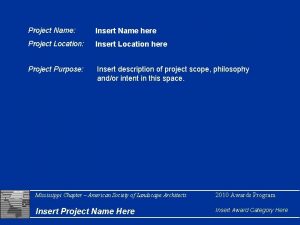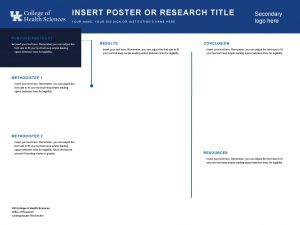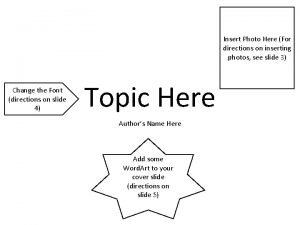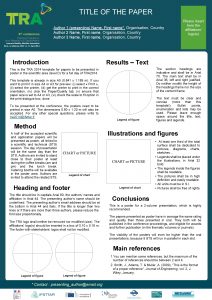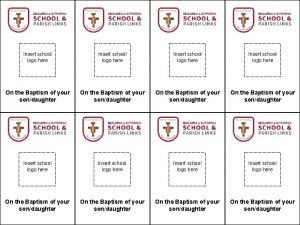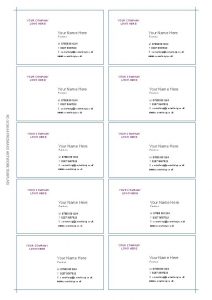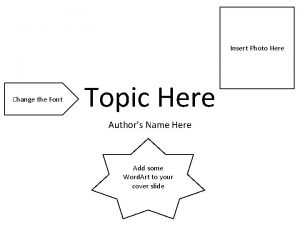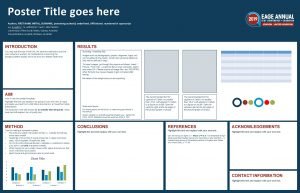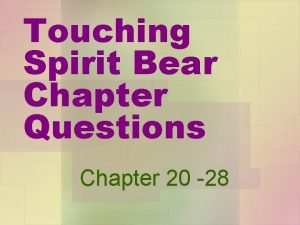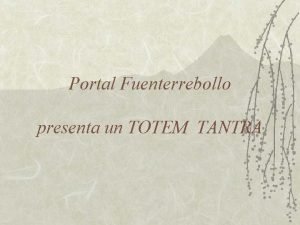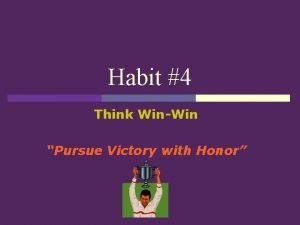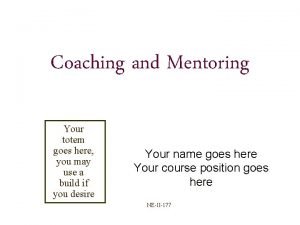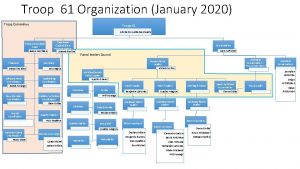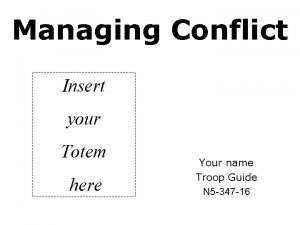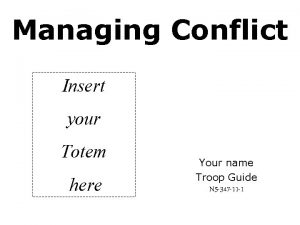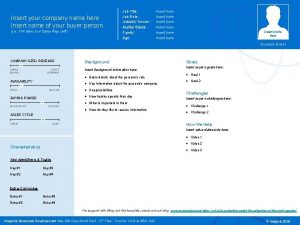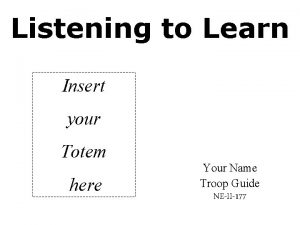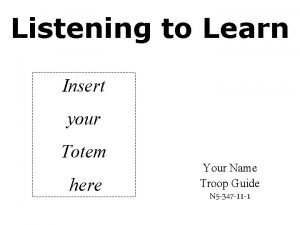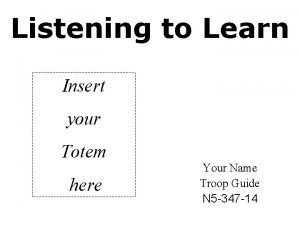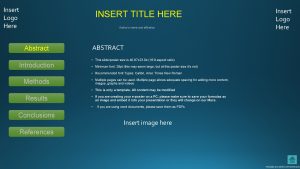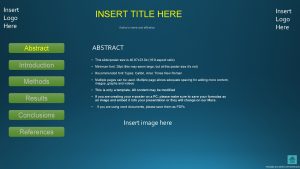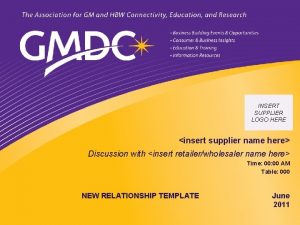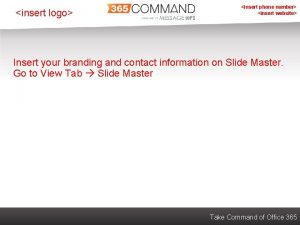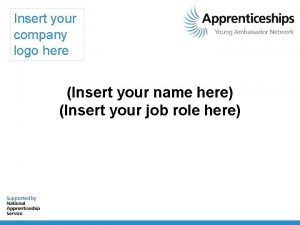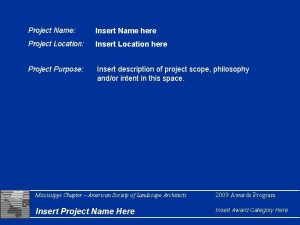Communication Insert your Totem here Your Name Troop

























































- Slides: 57

Communication Insert your Totem here Your Name Troop Guide N 5 -347 -11 -1

Communication Provide ground rules: • Distribute handout • Encourage note taking • Feel free to ask questions at any time N 5 -347 -11 -1 1 A

Learning Objectives Upon completion of this presentation you will: • Relate the experience of the Communications Trap game to basic principles of communication • Understand how listening can be an important part of communication • Develop strategies to overcome barriers to communication • Practice some skills of effective instruction N 5 -347 -11 -1 2

Learning Objectives Upon completion of this presentation you will: • Relate the experience of the Communications Trap game to basic principles of communication • Understand how listening can be an important part of communication • Develop strategies to overcome barriers to communication • Discuss some skills of effective instruction N 5 -347 -11 -1 2 A

Communications Traps Debrief: • • What did you experience as a team? What barriers could the obstacles represent? Could you have communicated more clearly? Did first or last team member have easier time? N 5 -347 -11 -1 3

Communications Traps Debrief: • • • What challenges did you face? Did this simulate an actual team situation? Did you trust your leader? What barriers could the obstacles represent? Could you have communicated more clearly? Did first or last team member have easier time? N 5 -347 -11 -1 3 A

Forms of Communication Baden Powell’s gravestone Trail Symbol: “I have gone home” Wood Badge beads The Gilwell Gazette and daily syllabus BSA uniform, patches Silent Signals Are these effective? N 5 -347 -11 -1 4

Forms of Communication • Gilwell song • The circle with the dot in it…on Baden-Powell’s gravestone (the trail symbol for “I have gone home” • BSA uniform, patches, Wood Badge beads • Wood Badge icon • The Gilwell Gazette, Wood Badge newspaper, including the schedule of the day Q: What do these forms of communication have in common? Board the responses on flipchart A: Some of these are non-verbal forms of communication. Discuss: What messages they convey? Are they effective or not? N 5 -347 -11 -1 4 A

Effective Communication N 5 -347 -11 -1 6

Effective Communication N 5 -347 -11 -1 6 A

ATTENTION! A Scout has just run up to our group and delivered this message: N 5 -347 -11 -1 7

ATTENTION! A Scout has just run up to our group and delivered this message: Flip this page now…. N 5 -347 -11 -1 7 A

First Aid Medical Emergency Form Who: Philmont Expedition 7 -30 F Eight Scouts, two adult leaders What: Bear attack. Two Scouts Mauled. Where: Lovers’ Leap Camp. When: One hour ago. Why: We need assistance. How: Bring an ambulance, medics, and first aid supplies. A really big bear trap could also prove useful. N 5 -347 -11 -1 8

First Aid Medical Emergency Form (Philmont Format) Who: Philmont Expedition 7 -30 F, Eight Scouts, two adult leaders What: Bear attack. Two Scouts Mauled. Where: Lovers’ Leap Camp. When: One hour ago. Why: We need assistance. How: Bring an ambulance, medics, and first aid supplies. A really big bear trap could also prove useful. Pretend for a moment that this message is real. Q: What is its impact? Q: Does it grab your attention? Why? Q: What are its strengths and weaknesses as a form of communication? Board their responses N 5 -347 -11 -1 8 A

Basic Blueprint of Communication • A sender • A message • A receiver What if any one of these is missing? N 5 -347 -11 -1 9

Basic Blueprint of Communication Aristotle broke down communication into three parts: • A sender • A message • A receiver That was over 2000 years ago, and it is still true today. It applies to all forms of communication—spoken, written, music, film, even pantomime. What if any one of these is missing? N 5 -347 -11 -1 9 A

Effective Listening as a Communication Tool Good communication: • Begins with “good listening” • Engages the minds of the receiver as well as the sender • Is a two-way process § Audience listens to the speaker § Speaker listens to the audience N 5 -347 -11 -1 10

Effective Listening as a Communication Tool Good communication begins with good listening, both on the part of the receiver and on the part of the sender. In “Listen to Learn” we discussed the importance of paying attention to what others are saying, their body language, etc. The most effective communication provides what the listeners need in a manner that engages their minds. It also engages the minds of the senders of the information. Whether they are communicating with one person or one thousand, they “listen” to their audiences by paying attention to the spoken and unspoken signals that indicate whether the message is getting through. Communication, then, is a two-way process. Both the sender and the receiver have responsibilities to make it happen. Feedback from the receiver helps guide the sender. DO NOT TURN SLIDE Engaging the Audience: Say in a nervous but sincere voice: “I want this presentation to be a success. If it doesn’t seem to be going well, could you let me know? If it’s not working, let’s do something about it and try to make it better. ” Pause and look at the reaction - NOW TURN THE SLIDE N 5 -347 -11 -1 10 A

Engaging the Receiver “What do you want? ” N 5 -347 -11 -1 11

Engaging the Receiver Ask: When I asked you that question, how did you respond? How did it make you feel as a listener, receiving information? Uncomfortable? Included? More engaged in the process? Have you ever had a speaker ask you that? Or a teacher or an employer or anyone else conveying information to you? Probably not. Most of the time we as speakers, teachers, Scout leaders, and supervisors have a preconceived notion of how a presentation will go. The speech is written out, the presentation is all prepared, and we’re going to push through it no matter what. If there is printed material or Power. Point slides to accompany the presentation, we can feel even more locked into a one-way street approach to communicating. “What do you want? ” It is the most important question in communication. We want knowledge. We want to learn a skill. We want to understand something. A speaker may not actually verbalize that question to an audience. But by having the question in mind, the speaker is going to be more aware of how an audience is responding, and thus more likely to open up a presentation and adjust it to better fit the needs of the receivers. “What do you want” If this is an unusual question for speakers to ask adults, think how rare it is for us to ask it of young people. So often we are sure we know what is best for them and we forge ahead without taking notice of the audience—the Scouts in our units, the young people in our lives. Effective communication must be two-way. If we don’t know what other people want, there is little chance we can provide the information they need. N 5 -347 -11 -1 11 A

Barriers to Effective Communication What are barriers to effective communication? N 5 -347 -11 -1 12

Barriers to Effective Communication We have all received phone calls from telemarketers. Most of us hate them. But Why? Q: What are the barriers to effective communication that a telemarketer must overcome? • Board their responses • Then turn this page and review the schooled answers. • Refer back to the board where theirs matched the schooled answer N 5 -347 -11 -1 12 A

Barriers to Effective Communication • Lack of common ground • Lack of sincerity • Lack of authority • Lack of clarity • Poor presentation skills • Lack of receptiveness • Environment N 5 -347 -11 -1 13

Barriers to Effective Communication • Lack of common ground: The telemarketer knows nothing about us and is aware of no shared interest except that we have a telephone and we probably have a credit card. • Lack of sincerity: The telemarketer is probably interested only in making a sale, not in out long-term satisfaction with a product or service. • Lack of authority: The telemarketer is probably hired simply to make the calls and read a script. We suspect that he or she is probably unqualified to answer questions of substance about the product. • Lack of clarity: The telemarketer may exaggerate, blur the truth, fail to mention weaknesses of a product. N 5 -347 -11 -1 13 A

Barriers to Effective Communication • Lack of common ground • Lack of sincerity • Lack of authority • Lack of clarity • Poor presentation skills • Lack of receptiveness • Environment N 5 -347 -11 -1 14

Barriers to Effective Communication con’t • Poor presentation skills: Telemarketers may badger people, argue with them, or be bored, distracted, barely there. • Lack of receptiveness: A telemarketer is not receptive to any needs we may have other than the desire for the product or service. Any discussion that isn’t leading toward a sale is considered wasted time. • Environment: Telemarketers disrupt our personal or family time, often calling during the dinner hour. This intrusion into our home environment generally makes people less receptive to their message than if they were to receive that same message in the mail, for example Even with all these drawbacks, telemarketing is successful frequently enough for many companies to invest millions of dollars in it. Just think how powerful communication can be when people take the time to overcome these barriers. N 5 -347 -11 -1 14 A

Good Communication What are ways to assure good communication ? N 5 -347 -11 -1 15

Ways to Assure Good Communication Q: What are ways to assure good communication? • Board their responses. • Then turn this page and review the schooled answers. • Refer back to the board where theirs matches the schooled answer N 5 -347 -11 -1 15 A

Ways to Assure Good Communication • Common Ground • Sincerity • Authority • Clarity • Good Presentation Skills • Receptiveness • Environment N 5 -347 -11 -1 16

Ways to Assure Good Communication • Common Ground: An important point of the Who-Me Game last evening was to learn something about the people in your patrol. The more we know about one another, the greater is the common experience that we share and the easier communication becomes. • Sincerity: Why can sincerity make a difference in our efforts to communicate with other? A speaker must care about the message and care about the receiver of that message. Otherwise there is no point in passing it along. • Authority: Ideally a speaker should know what he or she is talking about. There will be times, though, when a speaker is not an expert in a subject. What becomes important then is the willingness to learn along with a group. A Scout leader who knows nothing about constellations can bring a star chart along on a campout. “I can’t tell the difference between the Big Dipper and the moon” he explains, “but I’d sure like to learn. Let’s figure this out together. While his technical skill in this particular area may not be high, his ability as a communicator permits him to maintain his authority as he engages the Scouts in an interesting and worthwhile learning experience. N 5 -347 -11 -1 16 A

Ways to Assure Good Communication (con’t) • Common Ground • Sincerity • Authority • Clarity • Good Presentation Skills • Receptiveness • Environment N 5 -347 -11 -1 17

Ways to Assure Good Communication (con’t) • Clarity: Speakers who care about their messages and care about their audiences are likely to communicate with clarity. Trying to hide part of a message or twist the truth leads to fuzziness and confusion. • Good Presentation Skills: What are some presentation skills you’ve seen during this course that enhances communication? Can you suggest a few presentation methods that can interfere with good communication? We may have nervous habits that get in the way of conveying a message. Perhaps we speak too quickly or too slowly. We might be able to improve eye contact, or do a better job with body language. It’s also important to devote sufficient time to preparing the messages we intend to present. N 5 -347 -11 -1 17 A

Ways to Assure Good Communication (con’t) • Common Ground • Sincerity • Authority • Clarity • Good Presentation Skills • Receptiveness • Environment N 5 -347 -11 -1 18

Ways to Assure Good Communication (con’t) • Receptiveness: How can a speaker tell what his or her audience want? How can you assess the way your listeners are responding to a presentation? If things aren’t going well, are we willing to ask what we might do differently? Later this week we will discuss ways to provide effective feedback. Receiving feedback from interested listeners can help any speaker become more effective. • Environment: The comfort of an audience can have a large impact on their ability and willingness to listen well. Consider the setting in which you will make a presentation or lead a discussion. Consider the temperature, distractions, lighting as well as seating arrangements and ways to enhance the physical comfort of audience members. N 5 -347 -11 -1 18 A

Communication in a Digital Era Today’s youth are masters of this! But there are issues we must be aware of, and teach our youth to watch out for… N 5 -347 -11 -1 19

Communication in a Digital Era Today’s youth are masters of this! But there are issues we must be aware of, and teach our youth to watch out for… How many of you use e-mail? Send text messages? (text) Blog or read blogs? Who has a Facebook account? Uses Twitter? N 5 -347 -11 -1 19 A

When Communicating with Scouts or adults via e-media: • The responsibility for anything you write is yours alone. • Be Authentic • Consider Your Audience • Exercise Good Judgment • Respect Copyrights and Fair Use • Remember to Protect Personal Information N 5 -347 -11 -1 20

Rules for Communicating with Scouts or adults via e-media: 1. The responsibility for anything you write is yours alone. Oren Michaels, CEO of Mashery. com, explains that “people tend to interpret having the ‘right’ to express themselves online as implying a lack of consequences when they say stupid things. ” That is NOT the case! You need to take responsibility for what you write, and exercise good judgment and common sense. 2. Be Authentic. Always include your name in anything you e-mail or post online. If you are embarrassed to attach your name to it, you should probably think twice about posting it. 3. Consider Your Audience. Always consider who might be reading your post or e-mail. While addressed to a colleague or parent, remember that another could distribute that to an infinite number of people. There is no privacy in electronic posting. N 5 -347 -11 -1 20 A

Communicating with Scouts or adults via e-media (con’t): • The responsibility for anything you write is yours alone. • Be Authentic • Consider Your Audience • Exercise Good Judgment • Respect Copyrights and Fair Use • Remember to Protect Personal Information N 5 -347 -11 -1 21

Rules for Communicating with Scouts or adults via e-media: 4. Exercise Good Judgment. Always refrain from comments that could be interpreted as demeaning, inflammatory, or racially charged. Remember that in digital communications, there is no body language or facial expressions, something you might think is funny could actually be taken as offensive. 5. Respect Copyrights and Fair Use. “A Scout is honest. ” Copying or downloading copyrighted material without paying the owner is stealing. Make the decision that you will honor the intellectual property of others and encourage those around you to do the same. 6. Protect Personal Information. �Personal information does not belong posted on the Internet. Be caut where you put your private information and who you are sharing it with. Remember, everything is not always as it appears on the Internet. N 5 -347 -11 -1 21 A

Communication in a Digital Era On Line Communication is a great tool! Remember to use common sense and it will strengthen your troop, pack, or crew --- not damage it. N 5 -347 -11 -1 22

Communication in a Digital Era On Line Communication is a great tool! Remember to use common sense and it will strengthen your troop, pack, or crew --- not damage it. N 5 -347 -11 -1 22 A

Effective Communication and the Teaching of Skills How did we use effective communication to teach you how to make your woggle? N 5 -347 -11 -1 23

Effective Communication and the Teaching of Skills An important use of effective communication is the teaching of skills. Scout leaders do this all the time. So do supervisors at the job, co-workers, community volunteers - in fact, just about everybody is called upon now and then to teach someone else how to do something. Yesterday someone taught you how to tie a woggle. What was the process? (Lead the group in a brief discussion of how they perceived the teaching of woggle tying to have occurred. ) How did we use effective communication to teach you how to make your woggle? (The group can provide feedback on the teaching techniques. What are the strong points? How might it be improved? ) • Board their responses. • Then turn this page and review the schooled answers. • Refer back to the board where theirs matched the schooled answer. N 5 -347 -11 -1 23 A

Effective Communication and the Teaching of Skills • It was hands on! • You could see the goal • There was a handout of the process • Employed multi-media • Leader demonstrated the process • Communication was verbal, visual, and tactile • Leader allowed you to make mistakes • Leader was generous with support and praise N 5 -347 -11 -1 24

Effective Communication and the Teaching of Skills • It was hands-on. Everyone had a cord from the beginning and was actively involved in the process • There was a finished woggle on hand so that the participants could see the goal they were learning to achieve • There was a hand-out with diagrams showing the steps of the process—a multi-media approach to skills instruction • A leader demonstrated the process. As they did, participants followed along, doing it themselves. The communication was verbal, visual, and tactile. • The leader let each participant work through each step, allowing everyone to make mistakes and to figure out corrections. However, if a participant went too far afield, the leader would gently bring him back to the correct method, thus avoiding too much frustration. • The leader was generous with support and praise. N 5 -347 -11 -1 24 A

Effective Skills Instruction Teaching a skill involves four very clear steps: • Explain • Demonstrate • Guide • Enable N 5 -347 -11 -1 25

Effective Skills Instruction Teaching a skill involves four very clear steps: • First, you Explain how to do the skill • Second, you Demonstrate how to do the skill • Third, you Guide others to do the skills, providing ongoing feedback. • Fourth, you Enable others to use the skill, providing them with the time, materials, and opportunity to use the skill successfully. Explain, Demonstrate, Guide, Enable…. The first letters of those words spell EDGE. This teaching method is called the Teaching EDGETM. The Teaching EDGETM is how we teach every skill in the troop and outside of Scouting whenever you are called upon to teach something. Tomorrow, Day 3, we will go into this method in greater detail. N 5 -347 -11 -1 25 A

Summary Communication: • Is a tool of leadership • Is essential to effective teams • Happens in the “common ground” • Should be clear and concise • Requires sender/receiver to consider each other • Is written, verbal, and non-verbal Feedback is a gift N 5 -347 -11 -1 26

Summary Communication: • Is a tool of leadership • Is essential to effective teams • Happens in the “common ground” • Should be clear and concise • Requires sender/receiver to consider each other • Is written, verbal, and non-verbal Feedback is a gift N 5 -347 -11 -1 26 A

Great Leaders Are Great Communicators N 5 -347 -11 -1 27

Great Leaders Are Great Communicators N 5 -347 -11 -1 27 A

Learning Objectives With the completion of this presentation you should be now able to: • Relate the experience of the Communications Traps game to basic principles of communication • Understand how listening can be an important part of communication • Develop strategies to overcome barriers to communication • Discuss some skills of effective instruction N 5 -347 -11 -1 28

Learning Objectives With the completion of this presentation you should be able to: • Relate the experience of the Communications Trap game to basic principles of communication • Understand how listening can be an important part of communication • Develop strategies to overcome barriers to communication • Discuss some skills of effective instruction N 5 -347 -11 -1 28 A

Thank You ! Insert your Totem here N 5 -347 -11 -1 29

Thank You ! Insert your Totem here N 5 -347 -11 -1 29 A

Change Control delete this slide for actual course presentation version Date Who 1 3/26/06 Fred Stringer Draft - source from NE-11 -130 Final 8/5/06 Kathy Koping Final – Source – Syllabus NE-II-159 Final 10/26/08 Steve Lang Final – Source – Syllabus NE-II-177 Final 02/24/11 Jerry Ceres Final – Source – Syllabus N 5 -347 -11 -1 Description of changes
 Name goes here
Name goes here Insert your name here
Insert your name here Logo name
Logo name Voice brand name
Voice brand name Insert your text here
Insert your text here Type name here
Type name here Insert your text here
Insert your text here Insert text here
Insert text here Insert your name
Insert your name Insert logo here
Insert logo here Insert pic here
Insert pic here Insert photo here
Insert photo here Please insert here meme
Please insert here meme Please insert here
Please insert here Please insert here
Please insert here Insert logo here
Insert logo here Insert picture here
Insert picture here Insert logo here
Insert logo here Your logo goes here
Your logo goes here Insert title here
Insert title here Numberblocks font
Numberblocks font Insert logo here
Insert logo here Insert logo here
Insert logo here Presenter insert
Presenter insert Insert logo here
Insert logo here How old is
How old is Your name goes here
Your name goes here Name goes here
Name goes here Slogan for kindergarten
Slogan for kindergarten Your name goes here
Your name goes here Your name goes here
Your name goes here Name
Name Insert company name
Insert company name Hurricane insert name
Hurricane insert name There's a place where streams of grace
There's a place where streams of grace Name a point that is collinear with the given points
Name a point that is collinear with the given points Insert the sub title of your presentation
Insert the sub title of your presentation Touching spirit bear chapter 28
Touching spirit bear chapter 28 Why are there few examples of totem poles from before 1900?
Why are there few examples of totem poles from before 1900? Theme of totem by thomas king
Theme of totem by thomas king Tlingit totem pole meanings
Tlingit totem pole meanings Rf totems
Rf totems Totem tantra
Totem tantra Win win win lose lose lose
Win win win lose lose lose Totem pole meanings
Totem pole meanings Arts visuels totem cycle 2
Arts visuels totem cycle 2 Totem tantra
Totem tantra Patrol totem
Patrol totem Totem pole badger
Totem pole badger Totem poles pictures
Totem poles pictures Totem pole elettronica
Totem pole elettronica Totem mentor
Totem mentor Spell totem pole
Spell totem pole Totem tantra
Totem tantra Totem ocean trailer express
Totem ocean trailer express Tantra totem
Tantra totem Tantra totem
Tantra totem Physics
Physics

